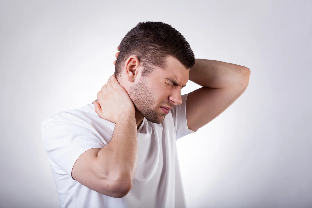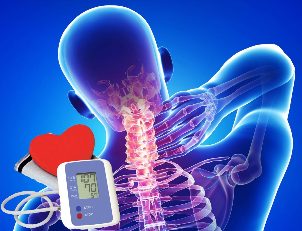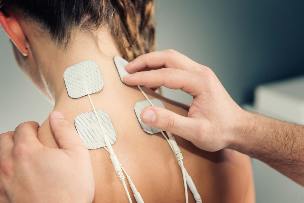Cervical osteochondrosis presents some degenerative changes of the intervertebral discs in the neck area.

The negative action of exposed not only the drives, but also the vertebrae, soft and cartilage of the fabric. The main feature of the cervical, is the fact that its vertebrae have not the most reliable structure in comparison with other departments is what makes this guest very vulnerable. The vertebrae here are located in close proximity to each other, and also to the heart, the arteries, which carry food to the human brain.
If there is a displacement of the vertebrae, there is a high probability, compression of nerve bundles and blood vessels, which inevitably leaves to the formation of a hernia between vertebrae and extrusion, i.e. changes to the structure of the spinal disk.
What is it?
Osteochondrosis of the cervical spine (Osteohondroz) – a degenerative-degenerative lesion of the intervertebral disc, which may result in damage to the actual discs, vertebrae and joints, a neck, there was a reduction in the height of the intervertebral disc. Disease progresses, if left untreated, can lead to the emergence of headache, disorders of blood circulation, and even hernia. As well as osteoporosis, the disease arises as a result of disturbances of the mineral exchange, thus the bones and joints become less rigid.
Osteochondrosis can cause instability of the cervical spine (the symptoms and treatment are similar with chondrosis, but they have a variety of functions), which are often accompanied by a shift of vertebrae. Again it accelerates the development of degenerative disc disease, destroying the spine of the department.
Phase
The attending physician should determine the degree of development of cervical degenerative disc disease, on the basis of the past, and also perform examination of the patient. There are only four grades:
- The first degree. The disease is located in the very bud, the patient observed a small pain in the neck, which may be more intense, if a person begins to rotate the head.
- Second grade. The patient may complain of very severe pain in the cervical region, which may be localized in the upper extremities. The clinical picture shows that at this stage of development of the disease occurred to a pinched nerve bundles, causing intense feelings of pain. Also celebrating headache, weakness and malaise.
- The third degree. Pains are almost, because of the constant, gives also in the shoulder, helena in hands. In some patients it is diagnosed with hernia of the intervertebral discs, which sees to the loss of sensitivity of the upper extremities. During the inspection of the doctor, there was a significant reduction in the mobility of the neck, as well as pain during palpation.
- The fourth degree. In this stage of the disease the intervertebral disc was almost completely destroyed. In its place appears the connective tissue, which sees to the deterioration of the condition of the patient. Begins to feel stronger pain, humming in the head, as well as poor orientation in space. This suggests that the artery will show a pinched, preventing the natural nutrition of the brain.

Symptoms of cervical degenerative disc disease
Important symptoms of degenerative disc disease of the cervical are dizziness, headaches, jumps in blood pressure.
Diagnosis of the disease is difficult, pain is sometimes not manifested, and the symptoms wears a deleted character, in addition, the uncontrolled use of strong analgesia masks the symptoms of the disease. The patient is not feeling pain, is considered to be healthy, and so continued until the development of irreversible processes in the tissues of the joints of the neck.
Headaches with cervical osteochondrosis
This is one of the most common non-specific symptoms of many diseases of man. Headaches, in particular, is widely distributed in the female population. It is very difficult to determine the cause of the headaches, and the more, tie it with a disability of the spine. Revealed about 14 different causes of headaches in people.
The most common causes of headaches in the us described the pathology:
- A spasm of cerebral vessels;
- A pinched nerve roots of the nerves;
- A reflex increase in intracranial pressure.
Headaches with cervical osteochondrosis may remind you of feelings in arterial hypertension, angina pectoris, helena stroke. The more people of middle and older age, are usually available the risk of developing stroke helena heart attack.
I feel like the pain may be paroxysmal, constant, throbbing and dull.
In the pathologies of heart patients complain of uncomfortable feelings in the chest area, accompanied by violation of rhythm of cardiac activity. Determine the cause can only a qualified doctor. In the case of the occurrence of the headache, combined with nausea, vertigo and pain behind the breastbone pain, make sure to performs ECG.

Dizziness in cervical osteochondrosis
Such a condition is not always clearly shows the degenerative disc disease of the cervical spine.
Dizziness may be the result of:
- Inflammation in the middle helena the inner ear;
- A spasm of cerebral vessels;
- Violations transmission of nerve impulses;
- Problems with the vestibular apparatus;
- Diseases of the cardiovascular system.
It is not clear criteria dizziness when osteochondrosis. However, there are systemic and non-systemic dizziness, have distinct differences.
It is recommended to know the differences of the system and non-system vertigo, it will help you to establish the causes of unusual condition:
- Systemic dizziness – it is a feeling of circular movement of the surrounding objects helen your body, which is a consequence of the interruption of the work of the vestibular system, visual analyzers and receptors in joints, muscles, and epidermis (osteochondrosis of different etiology);
- Non-system dizziness – this is the feeling of nausea, feeling stunned, not sure of the condition in the upright position. When a non-system dizziness a feeling of circular rotation is missing, and that is the fundamental difference of the marks.
Man, the feeling of dizziness one of the listed types, it shall, to be examined by an experienced doctor, in the first place, the neurologist helena (if there is a suspicion on disease of the ear and throat) an otolaryngologist.
The reason for the emergency hospitalization, is not associated with osteos chondrosis of the cervical spine, is to identify the patient (plus vertigo), as a sign, as:
- Paralysis of the facial muscles, and numbness of the shoulder girdle;
- Severe headache on the background of deterioration of well being;
- Disorders of coordination of movements;
- The loss of helena extinction of consciousness.

Blood pressure in the cervical osteochondrosis
The connection of cervical degenerative disc disease with jumps in blood pressure a long time ago established. The neck vertebrae have important nerve endings and blood vessels.
They are characteristic races, the pressure in the course of the day. Hypertension for a long time is not typical for this disease. Reflex irritation of the nerve endings and the short-term spasms of the blood vessels causing bouncing of the daily dynamics of arterial hypertension.
A distinctive feature of the high pressure in the cervical osteochondrosis is a combination with the following symptoms:
- Headaches;
- Pain in the limbs and on the chest;
- Decrease of sensitivity in the collar area;
- Occurrence of surge pressure after stress, muscle tension, prolonged stay in an uncomfortable position, and other similar situations.
These symptoms should be taken into account in the own differentiation of hypertension of different genesis.
Sharp racing HELL and the rapid deterioration of wellbeing are the basis for the submission of requests for urgent medical help.
Syndromes are degenerative disc disease
The clinical picture of the pain of cervical degenerative disc disease can fit into several syndromes. Syndrome is a number of symptoms that occur together.
Osteochondrosis consists of the following syndromes:
- Vertebrae. It is also called vertebrae, that points out that pathological process involved the bone and cartilage of the fabric. It sees to the emergence of these symptoms: restriction of motor activity of the neck, pain when turning, radiological changes on the image of the cervical spine. This is the reason, the simultaneous occurrence of these symptoms is vertebrae syndrome. A similar set of clinical symptoms observed in myositis (pathology of muscle tissue), and painful movements of the satellite, many other pathologies.
- Syndrome vertebral artery. Is displayed when connecting to the process of vascular bundles, which are responsible for supplying blood to the tissue of the central nervous system. Symptoms talking about the fact that brain tissue has ceased to take for granted the amount of useful substances. How to recognize this syndrome? The first symptoms are dizziness, a feeling of buzzing in the ears, changes in blood pressure, the emergence of the "shroud" in front of the eyes. This suggests that one of the vertebral artery is located in the stavlennia condition. Each container has its nerve endings. If squeeze those that Innervate the vertebrae blood vessels appear migraine, numbness, short-term decline, a view from one side. Due to changes in blood vessels lead to the fact that the brain needs oxygen. At this time the person feels drowsiness, short-term disturbance of consciousness, losing consciousness and control, the worse it works and stores information. When this clinical picture it is necessary to distinguish cervical osteochondrosis with atherosclerosis of the vertebral arteries, and compression of the tumour helena inflammation.
- Cardiac syndrome. Manifested by a burning sensation in the chest area,the onset of shortness of breath. One feels his frequent heart palpitations, becomes tired and irritable. Such a picture is characteristic for cardiac pathology, for example, for angina, coronary syndrome, heart attack. The exact conclusion about the causes of these symptoms, it is possible that after the patient will be held ECG.
- Root syndrome. The cervical department innervates 8 pairs of nerves, each of which has a roots point of exit of the nerve from the vertebra. At the time of their involvement in osteochondrosis, the patient experiences a decrease in the sensitivity of helena, on the contrary severe pain. Can lead to numbness of the neck, zdf is his soreness, numbness of the tongue, the BTE region, pain in the supraclavicular area. Sometimes occur disorders of swallowing, movements in the girdle of the upper limb, numbness of the fingers on the hands.
First aid in the home in the focus of degenerative disc disease
During a strong pain syndrome, it is possible to use analgesics such as Analgin, Tempalgin helena Baralgin. If the above medications do not bring relief, you can take nsaids (Nise helena Diclofenac).
Often used "dispersal" means, such as a Pepper patch, which does not cure, but only warms the inflamed area and distracts from the pain. In the case of education swelling in the area of inflammation, the patient may drink infusion of herbs helena diuretic in the course of 3-4 days. You can cure osteochondrosis of such methods? These measures are only temporary, for the treatment of the causes, that it is necessary to seek medical help.
It should be noted what kind of doctor treats degenerative disc disease. When it appears a suspicion, that the causes of pain in the cervical region of the spine – it is the occurrence of degenerative disc disease, it is necessary to turn to the only neurologist. Is this a specialist dealing with diseases of this kind. In some medical devices is a narrow experts, engaged in exactly the disease of the spine. If in your clinic there the spine, you should contact with the question of how to treat this disease, immediately to him.

How to treat osteochondrosis of the cervical?
In the initial stage of development to treat the osteochondrosis can be without medication, enough to rethink the diet, the mode of the day, regularly carry out a complex of special exercises. In more advanced forms of the disease effective treatment is possible only under condition of use of various drugs, which help to suspend the degenerative changes in the vertebrae.
In the complex therapeutic measures necessarily include physiotherapy – electrophoresis with medicines, ultrasound, magnetic therapy, laser. These methods help cope with the pain, inflammation, tissue swelling, improve the processes of metabolism and blood circulation.
Treatment treatment
The main methods of treatment of degenerative disc disease of the cervical spine – it is the treatment treatment, physiotherapy, massage of the neck-collar area, in particular, effective physiotherapy in cervical osteochondrosis. The main groups of drugs used in this disease include:
| Name | The principle of |
| Non-steroidal anti-inflammatory drugs (NSAIDS). It voltaren, Nise, Movalis, have a Ketonal, Ketanov, diclofenac, nimesulide and other | Reduce painful, promote the breakdown of aseptic inflammation and swelling of the root of the damaged nerve. |
| Drugs to improve the rheological properties of blood and blood circulation. This aminophylline, trental. | Improving the nutrition of the damaged nerve roots and improve blood flow to the brain. |
| Vitamins of group In. It combilipen, unigame, milgamma, neurobion. | Improve the metabolic processes in the nervous tissue. |
| Muscle relaxants. This mydocalm, sirdalud, sharp, tizanidine, etc. | Are drugs the removal of the spasm of the muscles. |
| Chondroprotectors. It's (glucosamine and chondroitin) artra, teraflex, doppelgerts, toad stone, Andronova, structovis, alflutop. | Are medicines to recondition cartilage of the fabric including the damaged intervertebral disk. |
Taking the pills from degenerative disc disease, it should be remembered that a significant effect of the pharmacological treatment with tablets will be just in that case, if you combine it with other methods, including exercise. Similarly, it should be noted that the attending physician should assign, than to cure the disease on the basis of her stage and other characteristics.












































